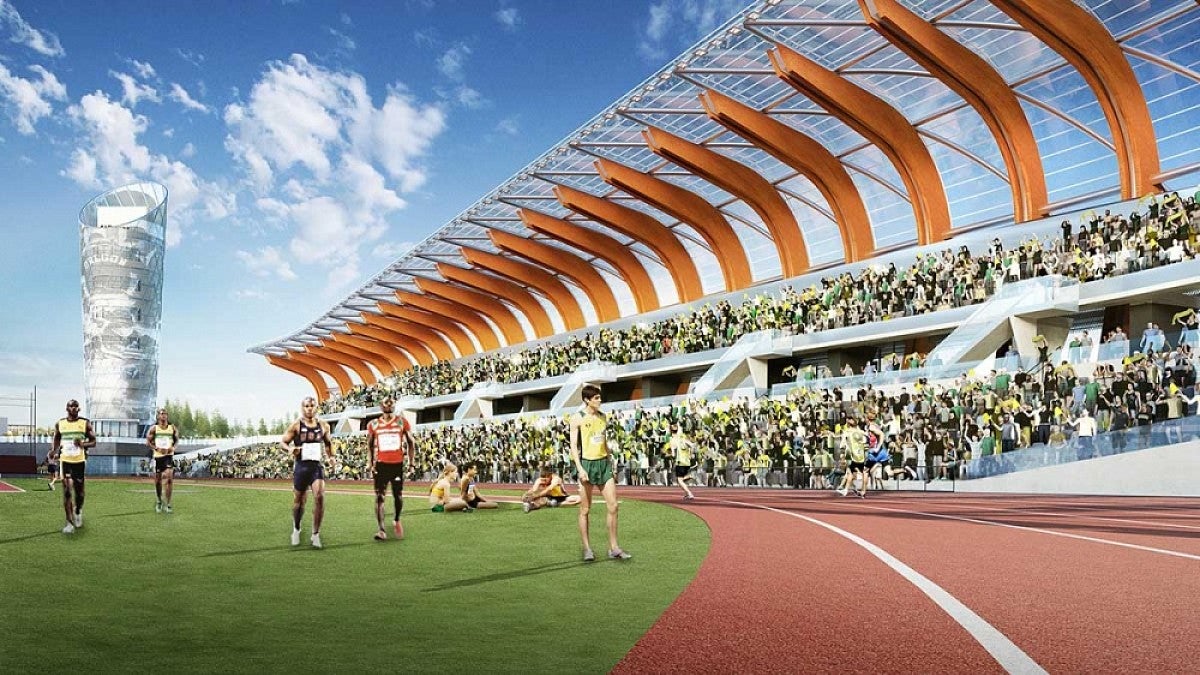The new design for the university’s iconic Hayward Field will address longstanding infrastructure needs while saving and repurposing as much of the old stadium as possible, campus leaders say.
The facilities will serve as a new home for UO men’s and women’s track and field program and world-class meets such as the Prefontaine Classic. It will also include space for updated human physiology department research and academic facilities.
The new stadium is fully funded by 50 donors, led by Phil and Penny Knight. The updated Hayward will increase permanent seating by more than 2,000 seats and preserve existing student recreational fields. Designs for the project were unveiled April 17.
“No one appreciates the history of Hayward Field more than the University of Oregon,” said Michael H. Schill, UO president and professor of law. “In fact, its legacy of excellence plays a critical role in the university’s identity as a top research institution. We do not take that legacy lightly, and we will look to preserve it as much as possible in the new facility.”
A renovation of Hayward Field has long been a priority for the UO. Early designs for the project were introduced in 2016 and included the preservation of the east grandstand. Since then, those plans evolved based on several factors, including cost, timelines and the integrity and safety of the current infrastructure.
Facilities designers and venue operators deemed the removal of the east grandstand necessary for several reasons. The current east grandstand was built in 1925, and, like many buildings that age, has critical structural challenges. It is not fully ADA compliant, lacking ramps and cane detection; does not meet modern seismic safety requirements; has many wood components coated in layers of lead-based paint; poses fire hazard risks; and has wood decay in many core areas.
“While we have worked hard over the years to ensure the east grandstand is safe for thousands of fans and athletes, it is not equipped for long-term occupancy,” said Mike Harwood, associate vice president for campus planning and facilities management.
According to designers and project managers, as many elements of the grandstand as feasible will be preserved, and the new facility will include salvaged and repurposed portions of the grandstand timber and beams for signage and photo opportunities for fans.
Additionally, the UO will preserve as much of the structure as is practical and possible for the benefit of the community. The construction project team, led by Portland-based Hoffman Construction, is exploring options and creating a plan that includes storing salvaged materials and facilitating a community process to provide advice and recommendations on what to do with them.
The renovation of the project is timed to maximize the number of track and field events that can be hosted at Hayward Field before constructions begins in summer 2018. Construction will conclude in time to host the 2021 IAAF World Track and Field Championships, the first time this event has taken place in the United States.
The cities of Eugene, Springfield and communities throughout Oregon are preparing for this event, otherwise known as Oregon21. Organizers estimate the event will bring nearly 2,000 athletes from more than 200 counties and tens of thousands of track and field fans.
“The Oregon21 Track and Field World Championships will undoubtedly serve as an important economic stimulus over the several-month training and completion period for many businesses and individuals throughout the region,” Schill said. “It will also serve as a catalyst to support even greater interest in our university and the wonderful energy and momentum that exists within our city, region and state. This incredible community that loves and feels such a strong connection to Hayward is part of what makes it a special place. We are committed to ensuring that the Hayward magic lives on.”


